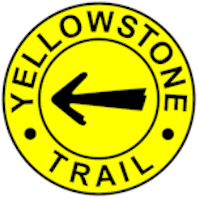
The Historic Yellowstone Trail
in Washington
A Brief History of The Yellowstone Trail

The Historic Yellowstone Trail
in Washington
A Brief History of The Yellowstone Trail
A Brief History of The Yellowstone Trail
The Yellowstone Trail was the first transcontinental automobile highway to cross the northern states from Plymouth, MA to Seattle, WA. The trail made Yellowstone National Park and the entire Pacific Northwest an accessible tourist destination for the automobile.
The highway began with Joseph W. Parmley in Ipswich, South Dakota on May 23, 1912. Originally Parmley wanted a good road from Aberdeen, SD to Mobridge, SD. Parmley and some local townsfolk began to work towards improving this road and not long after, the concept of "Good Roads" quickly became a nationwide movement to build a transcontinental highway from Plymouth Rock to Puget Sound.
Construction on the highway began on July 11, 1912. By October, the road had expanded to include Montana, and a road to Yellowstone National Park, thus the Yellowstone Trail was born. The route of the highway followed the established rail lines of the Milwaukee railroad to Cartersville, MT, and the Northern Pacific railroad to Three Forks. Railroad tracks followed the best grades, and their routes already had established towns which could provide gasoline and other services for travelers on the trail.
By 1915, the route had expanded to incorporate the existing roads between Chicago and Seattle, and by 1916 the Yellowstone Trail could finally advertise a "good road" from Plymouth Rock to Puget Sound. From Montana the route followed parts of the Old Mullan Road and the Milwaukee railroad. The trail made it's way through Coeur d‘Alene, ID to Spokane, WA. The Coeur d'Alene to Spokane segment of highway gained the moniker "Apple Way" because of the apple trees which were planted along much of the distance.
From Spokane to Seattle, the Yellowstone Trail organizers considered two options. The first was to follow the Sunset Highway which was a more direct route west across the Columbia Plateau. This route traveled over Old Blewett Pass to Cle Elum, where it turned west toward Snoqualmie pass. The second option was a longer route which traveled south from Spokane to Walla Walla, then northwest through Yakima to Cle Elum. The organizers chose the longer route because Blewett pass was not yet a "good road." By 1925 Blewett Pass had become a good road, and this prompted the Yellowstone Trail Association to formally change the route of the trail to follow the Sunset Highway, saving motorists some 150 miles
The summer of 1916 saw the first drive for publicity along the entire Yellowstone Trail. The roughly 3,700 miles would take about 5 days to complete at an average speed of 31 miles per hour. Joseph Parmley’s vision of a great transcontinental highway was complete.
By the late 1920's, the name "Yellowstone Trail" was beginning to disappear. This was because of the Federal Highway Acts of 1916 and 1921, which increased federal and state funding for interstate highways, and this led to the practice of designating federal roads by a number.
Today, towns all across the original route of the Yellowstone Trail are beginnings to post signs designating this historic highway through their towns. The Yellowstone Trail which began as a modest proposal in South Dakota endures to this day.